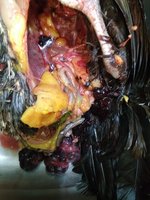Hi, seeing if I can get some insight into my bird's death.
Speckled Sussex was 10 months old. I observed no symptoms until I found her laying under the roost, barely conscience. She died only a couple hours afterward.
She was secreting watery discharge from her cloaca which was tinged red. That thread is here: https://www.backyardchickens.com/threads/chicken-dying-sleeping-not-alert.1221972/
I know this is not proper necropsy technique, but we're just feeling tired tonight and needed to at least take a look inside and see if there was anything obvious.
Again, sorry for the shotty job. Also forgot to check the mouth and neck. I don't believe she had anything in her crop.
View attachment 1268249 View attachment 1268250 View attachment 1268251 View attachment 1268252 View attachment 1268253 View attachment 1268254
Thank you for taking the time to share your photos with us.
Again, I'm sorry you lost her.
I'm not a vet nor an anatomy expert, hopefully the others will chime in shortly with their thoughts.
@Eggcessive @casportpony @TwoCrows @speckledhen @rebrascora
The first thing that stands out in the photos to me is the amount of fat in the abdomen. This can cause a great deal of stress on the internal organs and they can have difficulty laying eggs. Too much fat can eventually lead to Fatty Liver Disease and cause them to bleed out. I don't really see any blood in the abdomen, but I would suspect she was having trouble passing an egg or she may have had a lot of pressure that ruptured small capillaries in the oviduct, this may have been the cause of the bloody discharge.
I glanced quickly back at your other thread and don't see you mention what type of food/treats that you give your girls. While I really do believe that some chickens are more prone to be fat (genetics), feed still plays an important part in controlling some health problems. We all love to treat our girls! I do, I have to watch myself, they are like little sweet faced beggars. A good rule to go by is to limit treats to no more than 5-10% of their daily intake depending on the protein content of the feed you give.





